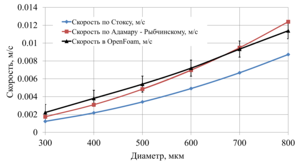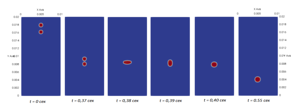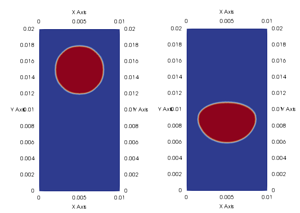

The article considers the process of gravitational sedimentation of water-in-oil emulsion droplets using numerical simulation. The OpenFOAM software package was used. The sedimentation of single droplets with different radii and their interaction was simulated. It was shown that the droplets retain a spherical shape with a diameter of less than 1 mm. With an increase in the droplet size, deformation is observed due to the uneven distribution of external pressure. The numerical results are compared with analytical solutions using the Stokes and Hadamard–Rybczynski formulas, which confirmed the correctness of the simulation. The process of merging two droplets when they approach each other, which occurs automatically within the VOF method, is also considered. It was found that the resulting droplet restores its spherical shape after deformation.
gravity sedimentation,
emulsion,
droplet,
OpenFOAM,
modeling,
deformation
Emulsions are currently used in many industries. For example, in chemistry, emulsions are separated in various types of chemical reactors. In the oil and gas industry, one of the urgent tasks is the separation of water-oil emulsions. In medicine, the method of gravitational separation of blood into components is used, allowing the separation of plasma from cellular elements - platelets, leukocytes and erythrocytes. One of the important tasks of physics is the destruction of stable dispersed systems, such as water-oil emulsions that spontaneously form during oil production. For economic and operational reasons, such emulsions must be separated to extract both the water and oil phases. To develop more efficient equipment for processing emulsions, it is important to deeply understand the factors affecting the formation and stability of emulsions. An adequate understanding of the mechanisms affecting droplet size, stability and sedimentation processes still requires new research and discoveries. This emphasizes the importance of studying and improving emulsion breaking methods. Physicochemical properties of dispersed systems and surface phenomena occurring in them play an important role in finding solutions to these problems. A numerical study of gravitational sedimentation of a single drop of a water-in-oil emulsion was carried out using the OpenFOAM software package. The purpose of the simulation was to study this process and compare the results of the numerical solution with the analytical solution. This mathematical model does not take into account the coalescence equation, so the process of combining (merging) droplets is implemented using the volume of fluid (VOF) method. When two or more droplets enter one computational cell, the VOF method automatically combines them into one drop. After combining, the droplet acquires a spherical shape and continues settling. The size of spherical droplets varies from 50 to 1000 ~ μm, which allows us to consider their motion viscous (Re ≤ 1). It is assumed that viscosity, density and temperature remain constant; liquids are considered immiscible, incompressible and Newtonian. There are no chemical reactions between the two liquids.
The paper studies the gravitational sedimentation of single and interacting water droplets in oil using numerical simulation in OpenFOAM. It was found that small diameter droplets (less than 1 mm) retain a spherical shape and move in a straight line. The dependence of the sedimentation rate on the droplet size agrees well with classical analytical models. It is shown that when droplets are deposited in an emulsion, they converge and merge, accompanied by a change in the shape of the resulting combined droplet, followed by restoration of the spherical shape. For large droplets, shape deformation is observed due to uneven pressure on the surface.





